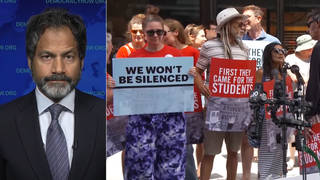
By Amy Goodman with Denis Moynihan
“In the next 60 seconds, 10 children will die of hunger,” says a United Nations World Food Programme (WFP) online video. It continues, “For the first time in humanity, over 1 billion people are chronically hungry.”
The WFP launched the Billion for a Billion campaign this week, urging the 1 billion people who use the Internet to help the billion who are hungry. But if you think that hunger is far from our shores, here is some food for thought … and action: The U.S. Department of Agriculture released a report Monday stating that in 2008 one in six households in the U.S. was “food insecure,” the highest number since the figures were first gathered in 1995.
Economist Raj Patel, author of “Stuffed and Starved: Markets, Power and the Hidden Battle for the World’s Food System,” told me he was “gobsmacked” by the U.S. hunger numbers, which he finds appalling: “The reason that we have this huge increase in hunger in the United States, as around the world, isn’t because there isn’t enough food around. Actually, we produced a pretty reliable solid crop last year. … The reason people go hungry is because of poverty.”
In addition to the online campaign, the United Nations is hosting the World Summit on Food Security in Rome this week, hoping to unite world leaders on the cause of eliminating hunger. Patel remarked on the U.N. summit, “They’re making all the right sounds about hunger around the world, but as some of the activists outside that summit are saying, poor people can’t eat promises.”
Almost 700 people from 93 countries, many of whom are small-scale food producers, have gathered outside the U.N. summit. They are there in behalf of the People’s Food Sovereignty Forum, and they are pushing for small-scale, organic, sustainable food-sovereignty and food-security programs, as opposed to large-scale agribusiness with its dependence on genetically modified organisms and chemical fertilizers and pesticides. Michelle Obama said last March when planting the White House’s organic kitchen garden, “It is so important for them [children] to get regular fruits and vegetables in their diets, because it does have nutrients, it does make you strong, it is all brain food.” The first lady of the U.S. made the point that a homegrown, organic garden is a sustainable and affordable way to strengthen family food security.
This has led some to wonder, then, why her husband has appointed Islam Siddiqui to be the U.S. chief agricultural negotiator. Siddiqui is currently vice president for science and regulatory affairs for CropLife America, the main pesticide industry trade association. According to the Pesticide Action Network of North America, “This position will enable him to keep pushing chemical pesticides, inappropriate biotechnologies, and unfair trade arrangements on nations that do not want and can least afford them.” It was CropLife’s mid-America division that circulated an e-mail to industry members after Michelle Obama’s garden announcement, saying, “While a garden is a great idea, the thought of it being organic made Janet Braun, CropLife Ambassador Coordinator, and I shudder.”
Jacques Diouf, director-general of the U.N. Food and Agriculture Organization, engaged in a 24-hour hunger strike over the weekend, before the food security summit kicked off. He said in a statement, “We have the technical means and the resources to eradicate hunger from the world so it is now a matter of political will, and political will is influenced by public opinion.” Diouf has estimated that it would take $44 billion per year to end hunger globally, compared with the less than $8 billion pledged recently to that goal. Juxtapose those numbers with the amount being spent by the United States in Iraq and Afghanistan.
According to the Center for Arms Control and Non-Proliferation, the U.S. has spent on average about $265 million per day in Afghanistan since the invasion of that country in 2001 (which is a much lower estimate than that provided by Nobel Prize-winning economist Joseph Stiglitz and others). Even at that rate, five months of military spending by the U.S. would meet Diouf’s goal, and that would be if the U.S. were the sole contributor.
Consider pausing this Thanksgiving, which for many in the U.S. is a major feast, to reflect on the 10 children who die of hunger every minute, and how your elected officials are spending hundreds of billions in public funds on war.
Amy Goodman is the host of “Democracy Now!,” an independent, daily global TV/radio news hour airing on more than 950 stations in the United States and around the world. She is the author of “Breaking the Sound Barrier,” recently released in paperback and now a New York Times best-seller.
© 2011 Amy Goodman












Media Options